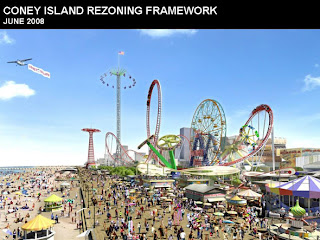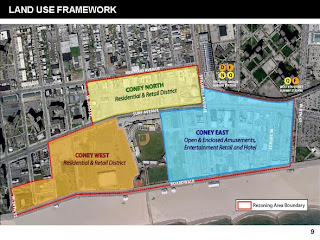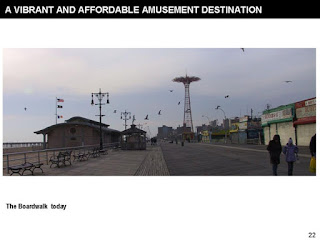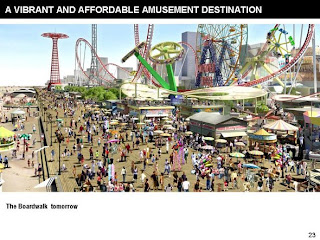Maybe some public, professionals, and institutional input can shape a better future for Coney Island, an international icon in need of a major makeover.
 On October 27 at Brooklyn Borough Hall, the Municipal Art Society (MAS) convened an extensive array of Coney Island stakeholders (minus one bigfoot) and an international team of designs and architects, in a remarkable effort to reimagine the redevelopment of Coney’s amusement area and surrounding blocks, beyond the images (right) in the city's rezoning plan. (MAS is funding the project, raising money from foundations and individuals.)
On October 27 at Brooklyn Borough Hall, the Municipal Art Society (MAS) convened an extensive array of Coney Island stakeholders (minus one bigfoot) and an international team of designs and architects, in a remarkable effort to reimagine the redevelopment of Coney’s amusement area and surrounding blocks, beyond the images (right) in the city's rezoning plan. (MAS is funding the project, raising money from foundations and individuals.)
The initiative, which MAS dubs Imagine Coney, stands in stark contrast to the civic response to other recent urban development initiatives, which had sufficient juice and/or consensus to short-circuit similar interventions. Consider that MAS entered the Atlantic Yards fray only in the summer of 2006, offering some cogent critiques of the project’s design and spawning the “mend-it-don’t-end-it” coalition BrooklynSpeaks, but was unwilling and unable to challenge a project then seen as inevitable.
 For Coney, MAS is soliciting ideas from the public, including events and activities, new amusement rides, design ideas, and housing- and retail-related ideas. (Might anyone suggest a sports arena?) Also welcome are thoughts, memories, and photos that might spur others to generate ideas. (Screenshot at right from Imagine Coney.)
For Coney, MAS is soliciting ideas from the public, including events and activities, new amusement rides, design ideas, and housing- and retail-related ideas. (Might anyone suggest a sports arena?) Also welcome are thoughts, memories, and photos that might spur others to generate ideas. (Screenshot at right from Imagine Coney.)
Entering the fray
Imagine Coney is partly a response to the city's contentious rezoning effort, but, given that zoning is not planning, it is a much broader look.
After the Greenpoint/Williamsburg and Downtown Brooklyn rezonings, and the Ikea and Atlantic Yards projects, all controversial, “we wanted to cheer” at the city’s plan for Coney, said MAS president Kent Barwick.
That plan, announced in November 2007, involved a new amusement area and more opportunities for entertainment-oriented retail, hotels and housing. In April 2008, after jousting with landowner Joe Sitt of Thor Equities, the city, which had opposed Sitt’s plan to put housing—first condos, then time-shares in the amusement area—revised its plans, agreeing to a smaller amusement area (in blue) and more space available for what is vaguely termed “entertainment retail.”
the city, which had opposed Sitt’s plan to put housing—first condos, then time-shares in the amusement area—revised its plans, agreeing to a smaller amusement area (in blue) and more space available for what is vaguely termed “entertainment retail.”
That change caused widespread dismay, with concerns that high-rise towers and shopping would encroach on land zoned for amusements, a rare status, with Coney Island Development Corporation (CIDC) member Dick Zigun of Coney Island USA resigning his position in anger.
The decision to cut the city-owned open-air amusement park from 15 acres to nine acres was “doubtful,” said Barwick, noting that experts think that’s too small a site to work.
Imagine Coney involves what MAS calls “a world-class team of designers, engineers, producers and economists” to rethink Coney as an international icon and lure for New Yorkers. Among them are Anne Hamburger, creative producer and David Malmuth, economist, both formerly of Disney; Soren Lund, former chief architect for Copenhagen’s Tivoli Gardens, and Will Alsop, the British architect responsible for the Urban Entertainment Centre in Almere near Amsterdam and the redevelopment of the riverfront district of Clarke Quay in Singapore.
Time pressures
 Even before the session, the Department of City Planning issued a statement from Chairperson Amanda Burden, warning, "It is imperative that the rezoning process and timeline not be jeopardized by any reconsideration of our proposed rezoning boundaries or urban design parameters."
Even before the session, the Department of City Planning issued a statement from Chairperson Amanda Burden, warning, "It is imperative that the rezoning process and timeline not be jeopardized by any reconsideration of our proposed rezoning boundaries or urban design parameters."
(At right and below, two images from the city's rezoning plan.)
The city understandably wants to start the rezoning process early next year, given that Astroland, the faded but well-loved existing amusement park, has been dismembered, leaving a hodgepodge of attractions along with landmarks like the Cyclone and the Wonder Wheel.
 Hence the accelerated schedule set up by MAS, with the initial presentations last Monday, public workshops on November 10 and November 12, design workshops on November 13 and November 14, and a public presentation at Borough Hall on November 17. “The aim is to restore Coney Island to be one of the world’s most exciting and original entertainment and amusement destinations once again,” MAS states.
Hence the accelerated schedule set up by MAS, with the initial presentations last Monday, public workshops on November 10 and November 12, design workshops on November 13 and November 14, and a public presentation at Borough Hall on November 17. “The aim is to restore Coney Island to be one of the world’s most exciting and original entertainment and amusement destinations once again,” MAS states.
I asked Barwick about Burden’s comment. He noted that MAS had approached Robert Lieber, the deputy mayor for economic development; city officials, according to Barwick, “said they would not be closed to new ideas but were in a course of action with a timetable.”
At the meeting
 The lineup at what MAS called the "Coney Island Charette Briefing Day" October 27 Monday was impressive, including Zigun, historian Charles Denson (right; more photos from the briefing day by ashford7.com), Astella Development Corp., the South Brooklyn Youth Consortium, and officials from several city agencies.
The lineup at what MAS called the "Coney Island Charette Briefing Day" October 27 Monday was impressive, including Zigun, historian Charles Denson (right; more photos from the briefing day by ashford7.com), Astella Development Corp., the South Brooklyn Youth Consortium, and officials from several city agencies.
Also, at least according to the program, the two major developers, Taconic Investment Partners and Thor Equities, were supposed to be present. Taconic, which has proceeded less controversially than Thor, did send a rep, endorsing the city's plan. Thor was absent.
I only stayed for part of the session, so I missed some of the major action (and the Atlantic Yards “gaffe” by Jon Benguiat of the Brooklyn Borough President’s Office). I did catch Benguiat make some cogent remarks, reminding the audience that Coney Island is not merely a state of mind but home to thousands of people.
Benguiat recalled a planner's adage that there are always physical solutions to physical problems, but the challenge "is to know when the problem is physical." Coney Island's plight--the condition of its streets and infrastructure--"just didn't happen."
Barwick saluted the city for making significant progress before the rezoning: stabilizing the Parachute Jump, restoring the boardwalk, buying the land under the Wonder Wheel, and buying and renovating the B&B Carousell, once located on the north side of Surf Avenue.
Metro reported that Brooklyn Borough President Marty Markowitz discussed the promise of a partially-enclosed amphitheater at Asser Levy Park, presaging a major upgrade for summer music events and potential ice skating and more events in the winter.
 Purnima Kapur, who heads the Brooklyn office of the Department of City Planning, said the city wanted to maintain an amusement core, develop jobs, and create an opportunity for neighborhood development, with streets, parks, and new housing, including 20% affordable. Wide Surf Avenue "has the potential to be a beautiful boulevard," she said; photo from city rezoning plan).
Purnima Kapur, who heads the Brooklyn office of the Department of City Planning, said the city wanted to maintain an amusement core, develop jobs, and create an opportunity for neighborhood development, with streets, parks, and new housing, including 20% affordable. Wide Surf Avenue "has the potential to be a beautiful boulevard," she said; photo from city rezoning plan).
The city would not only map nine acres of parkland--too little, according to critics--it would add new east-west streets to enhance street life.
The conflict with Sitt
Apparently some of the panelists were concerned about high-rises in the amusement district, which Sitt seems to want. “It doesn’t matter if it’s [built] high. It’s the lower level that matters,” Lund said, according to Metro. “[A] compromise that takes a little of this and that — that’s the way not to do it. You kill the uniqueness. Putting a hotel here, a condo here — that doesn’t work.”
Beyond the boardwalk
 City Council Member Dominic Recchia, an ally of Sitt, didn't mention the developer in his remarks, but talked about his dream to bring live theater to the Shore Theater across the street from the subway station and the importance of building a new community center outside the amusement district.
City Council Member Dominic Recchia, an ally of Sitt, didn't mention the developer in his remarks, but talked about his dream to bring live theater to the Shore Theater across the street from the subway station and the importance of building a new community center outside the amusement district.
(Screenshots at right from Imagine Coney.)
Brooklyn Parks Commissioner Jules Spiegel reminded the audience, "As long as summers are hot and people need to cool down, there will always be a Coney Island." He cited the various efforts, in and out of the amusement district, to rehabilitate parks in Coney Island.
Madelyn Wils, executive VP for the New York City Economic Development Corporation, described Coney Island as "a great opportunity and significant challenge... What gives us hope is the bones that made Coney Island a destination are still there."
 Among the challenges: the perception of decline; the fact that new amusement parks are built in year-round warm climates; and the transformation of a destination now seen as seasonal.
Among the challenges: the perception of decline; the fact that new amusement parks are built in year-round warm climates; and the transformation of a destination now seen as seasonal.
The transformation will require the city "to invest an unprecedented amount of money," she said, adding that "the revitalization will be more challenging in these difficult economic times."
Lynn Kelly, president of the CIDC, described the establishment of Steeplechase Plaza on the site of a soccer field adjacent to Keyspan Park. The grade will be changed to connect with the boardwalk, and the B&B Carousell, the last of its kind, will be moved there. Beyond that, the CIDC this month for the first time will exhibit at the International Association of Amusement Parks and Attractions.
With all the progress, there's still room for new ideas--and, probably, a debate about the zoning.
 On October 27 at Brooklyn Borough Hall, the Municipal Art Society (MAS) convened an extensive array of Coney Island stakeholders (minus one bigfoot) and an international team of designs and architects, in a remarkable effort to reimagine the redevelopment of Coney’s amusement area and surrounding blocks, beyond the images (right) in the city's rezoning plan. (MAS is funding the project, raising money from foundations and individuals.)
On October 27 at Brooklyn Borough Hall, the Municipal Art Society (MAS) convened an extensive array of Coney Island stakeholders (minus one bigfoot) and an international team of designs and architects, in a remarkable effort to reimagine the redevelopment of Coney’s amusement area and surrounding blocks, beyond the images (right) in the city's rezoning plan. (MAS is funding the project, raising money from foundations and individuals.)The initiative, which MAS dubs Imagine Coney, stands in stark contrast to the civic response to other recent urban development initiatives, which had sufficient juice and/or consensus to short-circuit similar interventions. Consider that MAS entered the Atlantic Yards fray only in the summer of 2006, offering some cogent critiques of the project’s design and spawning the “mend-it-don’t-end-it” coalition BrooklynSpeaks, but was unwilling and unable to challenge a project then seen as inevitable.
 For Coney, MAS is soliciting ideas from the public, including events and activities, new amusement rides, design ideas, and housing- and retail-related ideas. (Might anyone suggest a sports arena?) Also welcome are thoughts, memories, and photos that might spur others to generate ideas. (Screenshot at right from Imagine Coney.)
For Coney, MAS is soliciting ideas from the public, including events and activities, new amusement rides, design ideas, and housing- and retail-related ideas. (Might anyone suggest a sports arena?) Also welcome are thoughts, memories, and photos that might spur others to generate ideas. (Screenshot at right from Imagine Coney.)Entering the fray
Imagine Coney is partly a response to the city's contentious rezoning effort, but, given that zoning is not planning, it is a much broader look.
After the Greenpoint/Williamsburg and Downtown Brooklyn rezonings, and the Ikea and Atlantic Yards projects, all controversial, “we wanted to cheer” at the city’s plan for Coney, said MAS president Kent Barwick.
That plan, announced in November 2007, involved a new amusement area and more opportunities for entertainment-oriented retail, hotels and housing. In April 2008, after jousting with landowner Joe Sitt of Thor Equities,
 the city, which had opposed Sitt’s plan to put housing—first condos, then time-shares in the amusement area—revised its plans, agreeing to a smaller amusement area (in blue) and more space available for what is vaguely termed “entertainment retail.”
the city, which had opposed Sitt’s plan to put housing—first condos, then time-shares in the amusement area—revised its plans, agreeing to a smaller amusement area (in blue) and more space available for what is vaguely termed “entertainment retail.”That change caused widespread dismay, with concerns that high-rise towers and shopping would encroach on land zoned for amusements, a rare status, with Coney Island Development Corporation (CIDC) member Dick Zigun of Coney Island USA resigning his position in anger.
The decision to cut the city-owned open-air amusement park from 15 acres to nine acres was “doubtful,” said Barwick, noting that experts think that’s too small a site to work.
Imagine Coney involves what MAS calls “a world-class team of designers, engineers, producers and economists” to rethink Coney as an international icon and lure for New Yorkers. Among them are Anne Hamburger, creative producer and David Malmuth, economist, both formerly of Disney; Soren Lund, former chief architect for Copenhagen’s Tivoli Gardens, and Will Alsop, the British architect responsible for the Urban Entertainment Centre in Almere near Amsterdam and the redevelopment of the riverfront district of Clarke Quay in Singapore.
Time pressures
 Even before the session, the Department of City Planning issued a statement from Chairperson Amanda Burden, warning, "It is imperative that the rezoning process and timeline not be jeopardized by any reconsideration of our proposed rezoning boundaries or urban design parameters."
Even before the session, the Department of City Planning issued a statement from Chairperson Amanda Burden, warning, "It is imperative that the rezoning process and timeline not be jeopardized by any reconsideration of our proposed rezoning boundaries or urban design parameters."(At right and below, two images from the city's rezoning plan.)
The city understandably wants to start the rezoning process early next year, given that Astroland, the faded but well-loved existing amusement park, has been dismembered, leaving a hodgepodge of attractions along with landmarks like the Cyclone and the Wonder Wheel.
 Hence the accelerated schedule set up by MAS, with the initial presentations last Monday, public workshops on November 10 and November 12, design workshops on November 13 and November 14, and a public presentation at Borough Hall on November 17. “The aim is to restore Coney Island to be one of the world’s most exciting and original entertainment and amusement destinations once again,” MAS states.
Hence the accelerated schedule set up by MAS, with the initial presentations last Monday, public workshops on November 10 and November 12, design workshops on November 13 and November 14, and a public presentation at Borough Hall on November 17. “The aim is to restore Coney Island to be one of the world’s most exciting and original entertainment and amusement destinations once again,” MAS states.I asked Barwick about Burden’s comment. He noted that MAS had approached Robert Lieber, the deputy mayor for economic development; city officials, according to Barwick, “said they would not be closed to new ideas but were in a course of action with a timetable.”
At the meeting
 The lineup at what MAS called the "Coney Island Charette Briefing Day" October 27 Monday was impressive, including Zigun, historian Charles Denson (right; more photos from the briefing day by ashford7.com), Astella Development Corp., the South Brooklyn Youth Consortium, and officials from several city agencies.
The lineup at what MAS called the "Coney Island Charette Briefing Day" October 27 Monday was impressive, including Zigun, historian Charles Denson (right; more photos from the briefing day by ashford7.com), Astella Development Corp., the South Brooklyn Youth Consortium, and officials from several city agencies.Also, at least according to the program, the two major developers, Taconic Investment Partners and Thor Equities, were supposed to be present. Taconic, which has proceeded less controversially than Thor, did send a rep, endorsing the city's plan. Thor was absent.
I only stayed for part of the session, so I missed some of the major action (and the Atlantic Yards “gaffe” by Jon Benguiat of the Brooklyn Borough President’s Office). I did catch Benguiat make some cogent remarks, reminding the audience that Coney Island is not merely a state of mind but home to thousands of people.
Benguiat recalled a planner's adage that there are always physical solutions to physical problems, but the challenge "is to know when the problem is physical." Coney Island's plight--the condition of its streets and infrastructure--"just didn't happen."
Barwick saluted the city for making significant progress before the rezoning: stabilizing the Parachute Jump, restoring the boardwalk, buying the land under the Wonder Wheel, and buying and renovating the B&B Carousell, once located on the north side of Surf Avenue.
Metro reported that Brooklyn Borough President Marty Markowitz discussed the promise of a partially-enclosed amphitheater at Asser Levy Park, presaging a major upgrade for summer music events and potential ice skating and more events in the winter.
 Purnima Kapur, who heads the Brooklyn office of the Department of City Planning, said the city wanted to maintain an amusement core, develop jobs, and create an opportunity for neighborhood development, with streets, parks, and new housing, including 20% affordable. Wide Surf Avenue "has the potential to be a beautiful boulevard," she said; photo from city rezoning plan).
Purnima Kapur, who heads the Brooklyn office of the Department of City Planning, said the city wanted to maintain an amusement core, develop jobs, and create an opportunity for neighborhood development, with streets, parks, and new housing, including 20% affordable. Wide Surf Avenue "has the potential to be a beautiful boulevard," she said; photo from city rezoning plan).The city would not only map nine acres of parkland--too little, according to critics--it would add new east-west streets to enhance street life.
The conflict with Sitt
Apparently some of the panelists were concerned about high-rises in the amusement district, which Sitt seems to want. “It doesn’t matter if it’s [built] high. It’s the lower level that matters,” Lund said, according to Metro. “[A] compromise that takes a little of this and that — that’s the way not to do it. You kill the uniqueness. Putting a hotel here, a condo here — that doesn’t work.”
Beyond the boardwalk
 City Council Member Dominic Recchia, an ally of Sitt, didn't mention the developer in his remarks, but talked about his dream to bring live theater to the Shore Theater across the street from the subway station and the importance of building a new community center outside the amusement district.
City Council Member Dominic Recchia, an ally of Sitt, didn't mention the developer in his remarks, but talked about his dream to bring live theater to the Shore Theater across the street from the subway station and the importance of building a new community center outside the amusement district.(Screenshots at right from Imagine Coney.)
Brooklyn Parks Commissioner Jules Spiegel reminded the audience, "As long as summers are hot and people need to cool down, there will always be a Coney Island." He cited the various efforts, in and out of the amusement district, to rehabilitate parks in Coney Island.
Madelyn Wils, executive VP for the New York City Economic Development Corporation, described Coney Island as "a great opportunity and significant challenge... What gives us hope is the bones that made Coney Island a destination are still there."
 Among the challenges: the perception of decline; the fact that new amusement parks are built in year-round warm climates; and the transformation of a destination now seen as seasonal.
Among the challenges: the perception of decline; the fact that new amusement parks are built in year-round warm climates; and the transformation of a destination now seen as seasonal.The transformation will require the city "to invest an unprecedented amount of money," she said, adding that "the revitalization will be more challenging in these difficult economic times."
Lynn Kelly, president of the CIDC, described the establishment of Steeplechase Plaza on the site of a soccer field adjacent to Keyspan Park. The grade will be changed to connect with the boardwalk, and the B&B Carousell, the last of its kind, will be moved there. Beyond that, the CIDC this month for the first time will exhibit at the International Association of Amusement Parks and Attractions.
With all the progress, there's still room for new ideas--and, probably, a debate about the zoning.
Comments
Post a Comment